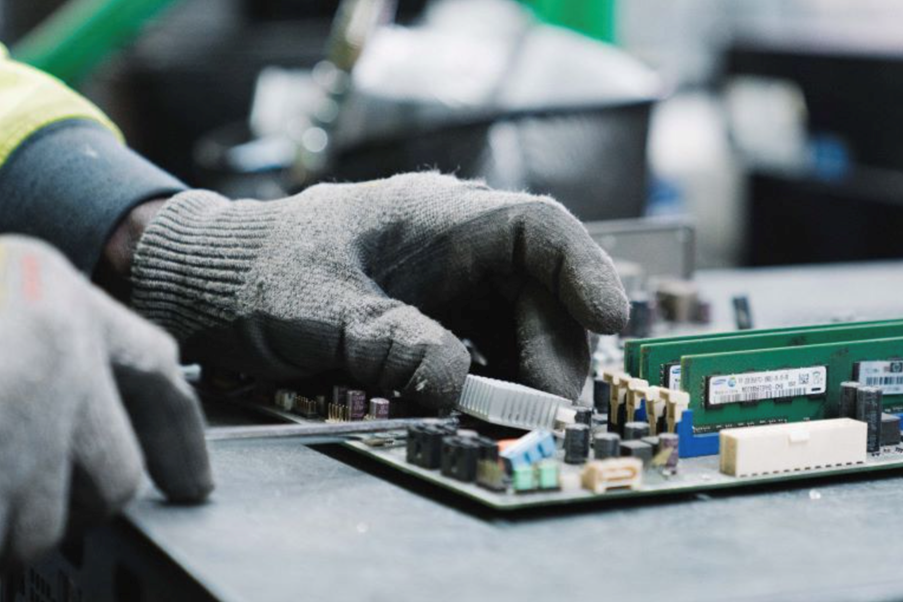Wired for Change – Sustainability Victoria interview on International E-waste Day 2023.
Electronic items are all around us. From the way we travel to how we entertain ourselves and even how we communicate, everything is becoming electronic. So it’s no surprise that electronic waste, or e-waste, is our fastest growing waste stream, increasing three times faster than any other form of waste.
In 2021 alone, Victorians generated around 170,290 tonnes of e-waste, which would weigh more than 400 jumbo jets.
E-waste is any unwanted item that uses a plug, battery or power cord, covering a wide range of everyday items like televisions, computers, hairdryers, mobile phones, kitchen appliances and white goods.
Containing both hazardous and valuable materials, e-waste has been banned from landfill in Victoria since 1 July 2019. To support the ban, the Victorian Government has invested $16.5 million in over 135 projects to help develop e-waste infrastructure and ensure that collection, storage and reprocessing of e-waste is operating at a high standard.
One of these projects is at Dandenong-based Scipher Technologies, where new state-of-the-art equipment is increasing processing capacity while also improving output quality.
Scipher’s Founder and Chief Commercial Officer Chris Sayers explains that there’s more to recycling e-waste than meets the eye, requiring specialised equipment and expertise.
“E-waste contains materials we can recover and recycle, like plastic, metals and glass, but it also contains hazardous elements like mercury, cadmium and lead, which are all damaging to human health.”
Chris Sayers, Founder and Chief Commercial Officer, Scipher Technologies.
“So there’s many health and safety considerations, and also a great amount of regulation and compliance within our industry. That’s why e-waste should only be handled by licenced and accredited recyclers.”
Funded by Sustainability Victoria, Scipher’s new equipment includes a heavy-duty shredder and an advanced optical sorter. Together, they are helping to make the complex job of recycling e-waste a little easier.
“The shredder is a very reliable piece of equipment,” Chris says. “The only thing it can’t shred is itself!
“The optical sorter uses infrared-based sensing technology to pick up the difference between metals and plastics. It can also identify different colours and sizes of waste fractions, which means our sorting has become more advanced.
“As well as boosting the volume we can process, this equipment is increasing both the quality and value of our output. We’re getting some pretty impressive results.”
After our e-waste goes through Scipher’s recycling process, the recovered raw materials like plastic, metals, glass and batteries are then sold to suppliers to make new electronic devices, car parts or items of furniture.
Chris says the high quality of Scipher’s recycled, raw materials continues to reduce our reliance on virgin materials.
“There’s a finite quantity of virgin materials in the earth, and if we keep extracting them ultimately they will be depleted, so we have to start recycling,” Chris explains.
“E-waste contains valuable elements bonded together which are difficult to separate, but as technology develops, we’ll be recovering and processing these materials to an even higher quality and the market demand for recycled product will only increase.”
When it comes to e-waste, Chris has seen it all. But he still gets excited whenever Scipher receives an old wooden framed, tube screen television set.
“Some of them arrive in pretty good nick, so it’s quite nostalgic. We’ve established a recycling line at Dandenong which we designed ourselves to specifically process that type of e-waste,” Chris says.
To ensure our unwanted electronic items are processed safely, it’s important not to throw them out in the household bin where they can start fires or leach toxic chemicals into the environment.
Almost 98% of Victorians live within a 30-minute drive of an e-waste drop off point you can check your local council’s recycling guide to find out what to do with a specific item.
Chris says it’s vital that unwanted electronic items are recycled correctly so the valuable waste stream doesn’t get exported overseas by traders.
“Everyone’s got a top drawer full of old mobile phones and batteries,” Chris says.
“When these items are taken to a licenced e-waste recycler, they can be processed and recycled onshore where the maximum amount of value will be extracted and reintroduced to the local economic cycle.”
To access the Sustainability Victoria article, click here »

